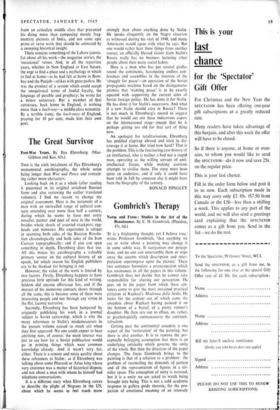The Great Survivor
THIS is the sixth instalment of Ilya Ehrenburg's monumental autobiography, the whole series being longer than War and Peace and contain- ing rather more characters.
Looking back on it as a whole (after reading it piecemeal in its original serialised Russian form and also reviewing the earlier translated volumes), I find no reason to change my original assessment. Here is the testament of a man with an unrivalled range of cultural con- tacts extending over more than half a century, during which he seems to have met every novelist, painter and poet of note in the world, besides whole shoals of assorted crackpots, egg- heads and minnows. His experience is unique in spanning both sides of the Russian Revolu- tion chronologically and both sides of the Iron Curtain topographically; and if you can span something in depth, Ehrenburg does that too. All this makes his autobiography a valuable primary source on the cultural history of an epoch, for which reason his English publishers are to be thanked for bringing it out.
However, the value of the work is limited by two factors. Firstly, Ehrenburg happens to have precious little aptitude for this kind of writing. Seldom did anyone effervesce less, and if the interest of his numerous contacts shows through all the same, this is because some of them were interesting people and not through any virtue in the flat, laconic narrative.
Secondly, Ehrenburg has been hampered by originally publishing his work in a journal subject to Soviet censorship; which is why the many references to Stalin's misdemeanours in the present volume caused so much stir when they first appeared. No one could expect to hear anything new, of course; the main interest was just to see how far a Soviet publication would go in printing things which were common knowledge already. And it wasn't very far, either. There is a remote and misty quality about these references to Stalin: as if Ehrenburg was talking about some Pharaoh or Aztec king whose very existence was a matter of historical dispute, and not about a man with whom he himself had telephone conversations.
It is a different story when Ehrenburg comes to describe the plight of Negroes in the US, about which he seems to feel much more strongly than about anything done by Stalin. He speaks eloquently on the Negro situation as witnessed during his visit of 1948, and many Americans would agree with what he says. But one would rather hear these things from another source; an officially blessed visitor from Stalin's Russia really has no business lecturing other people about their nasty social habits.
Here is a man who has put several girdles round the continents, haranguing endless con- ferences and assemblies in the interests of the `struggle for peace'—an operation of the Soviet propaganda machine based on the disingenuous premiss that 'wanting peace' is to be exactly equated with supporting the current aims of Soviet foreign policy. He has done it for Stalin. He has done it for Stalin's successors. And what if a new Stalin should arise in Russia? There is not much in Ehrenburg's record to suggest that he would cut out these indecorous capers on the international stage—except that he is perhaps getting too old for that sort of thing now.
An apologist for totalitarianism, Ehrenburg has peddled claptrap abroad and tried to dis- courage it at home. But tried how hard? That is the problem. This is the fascinating case-history of an intellectual, who is neither a bad nor a stupid man, operating as the willing servant of anti- intellectual forces, while making cautious attempts to civilise them. The story must have quite an undertow, and if only it could have been told in full by someone else it might have been the biography of the century.
RONALD HINGLEY






























 Previous page
Previous page